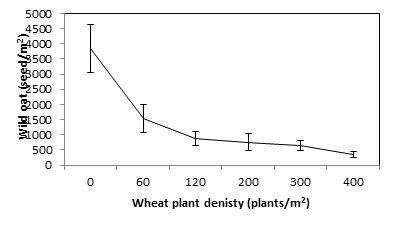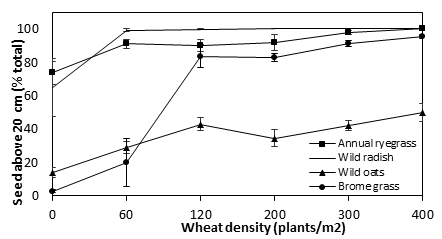The challenge of managing Wild Oats in northern region cropping
Author: Michael Walsh, Director Weed Research, University of Sydney | Date: 07 Mar 2017
Take home message
Sustaining herbicide the efficacy of herbicides available for wild oat control is going to be extremely difficult. Herbicides will remain critical to the ongoing effective management of wild oats in northern cropping region. The real challenge is that the only alternate strategies currently available for routine use within winter crops are crop competition and harvest weed seed control, which have reduced efficacies and are difficult to implement effectively compared to herbicides.
Background
Wild oats is the most competitive grass weed infesting northern region cropping systems. Wild oat plants are just as competitive as wheat plants, and therefore at low infestations (<10 plants /m2) can cause significant yield losses (>20%) (Quail and Carter, 1968; Radford et al., 1980). It is the most widespread weed of the northern cropping region infesting approximately 600,000 ha, costing growers about $4.5M annually due to control costs and production losses.
As with all annual weed species wild oats has the ability to establish and maintain a viable seed bank. Potential seed production is high, up to 10,000 seed/m2 in large infestations however, within crop, wild oats typically produces about 225 seed/plant (Medd, 1996). Once established, a large viable seedbank ensures that this weed will be an ongoing problem that will annually impact on crop production. Although the wild oat seed in the soil seed bank have a relatively short life span, regular annual inputs maintain seed bank viability. Without these inputs, a seedbank can be completely depleted in 3-4 years (Martin and Felton, 1993).
Herbicide Resistance is now a relatively common occurrence in wild oat populations occurring in Australian cropping systems. Random surveys of many cropping regions have identified high frequencies of resistance to Group A ‘fop’ (40% diclofop WA and NSW) and ‘Dim’ (30% tralkoxydim NSW) herbicides (Table 1). At present there are much lower levels of resistance to other herbicide modes of action commonly used to control this weed (i.e. Group B (2-10% mesosulfuron)). Although there is herbicide resistance present in northern region wild oat populations the frequency of resistance is not currently well quantified. A random herbicide resistance survey of this region is currently underway, with the results to be available in 2018.
Resistance evolution continues to occur in wild oat populations but fortunately at much slower rates than has occurred in other problematic weeds (e.g. annual ryegrass and wild radish). The biological attributes of self-pollination and hexaploidy are responsible for the slower evolutionary process that nonetheless still occurs and results in the loss of herbicide use.
Table 1. Proportion of randomly collected wild oat populations with resistance to a range of herbicides1
|
Active ingredient |
Trade name |
WA-2 |
NSW |
SA |
Vic |
|
Triallate |
Avadex® |
0 |
0 |
||
|
Diclofop |
44 |
37 |
≥2 |
||
|
Clodinafop |
Topik® |
4 |
8 |
||
|
Haloxyfop |
Verdict® |
2 |
2 |
||
|
Fenoxaprop |
27 |
4 |
|||
|
Pinoxaden |
Axial® |
3 |
8 |
2 |
1 |
|
Tralkoxydim |
Achieve® |
8 |
32 |
2 |
|
|
Sethoxydim |
Sertin® |
8 |
8 |
||
|
Clethodim |
Select® |
0 |
0 |
0 |
|
|
Mesosulfuron |
Atlantis® |
2 |
0 |
4 |
10 |
|
Imazamox + Imazapyr |
Intervix® |
1 |
|||
|
Glyphosate |
0 |
0 |
|||
|
Paraquat |
0 |
||||
|
Flamprop |
8 |
10 |
7 |
6 |
|
|
Trifluralin |
0 |
1Data from (Broster et al., 2013; Owen and Powles, 2016) and Boutsalis pers. Comm.-2 NSW and WA values are proportion of populations with at least 1% survival while Vic and SA values are for >20% survival to recommended rate.
Attack the seedbank
The overall aim for any weed management plan focusing on annual weeds must be the seedbank. The easiest approach to targeting the wild oat seedbank is to prevent the input of fresh seed. Wild oats has a relatively short lived seedbank (3-4 years) so preventing seedbank replenishment will potentially eliminate this weed in relatively short period of time.
Herbicide options
Herbicides are, and can remain, the most effective tool for controlling wild oats in northern region cropping systems. Despite significant herbicide resistance levels these are mostly confined to Group A herbicides and particularly to ‘fop’ herbicides. There remain several in-crop selective herbicide options available for wild oat control. As well as preventing seedbank inputs, in-crop control during the growing season also removes the significant competitive effects of wild oats on crop plants. Additional pre-emergence herbicide options have become available of the last few years (Mark Congreve, Ecology and management of Wild Oats webinar). There are also later season herbicide options (pinoxaden and flamprop) available for specifically targeting the seed production of wild oat plants.
Harvest weed seed control
Harvest weed seed control (HWSC) can play a part in wild oat management but is likely to be in addition to current control tactics and not likely to be robust enough to be able to be relied on as a stand-alone option. Although high proportions of seed retention have been recorded for wild oat populations maturing in wheat crops, seed shedding begins at plant maturity and continues throughout the harvest period (Walsh and Powles, 2014; Widderick et al., 2014). Therefore, although there is an opportunity to target wild oats with HWSC, this opportunity may be brief. There is a further research need to quantify the general efficacy of HWSC systems on this weed.
Crop competition
Increasing the competitive ability of crops has a major role to play in the management of wild oats as well as other weed species. Over many years several studies have identified the benefits of increasing competition on wild oat management specifically in relation to reducing seed production (Martin and Felton, 1993; Radford et al., 1980) as well for improving herbicide efficacy (Walker et al., 2002).
In a recent pot study, we observed a 40% reduction in wild oat seed production by increasing wheat plant density from 60 to 120 plants/m2 (Figure 1).

Figure 1. Influence of increasing wheat plant density on wild oat seed production
This same competition study found that wheat crop competition increased the proportion of seed retained higher in the canopy. (Figure 2). Increasing the height of seed retention height potentially improves the efficacy of HWSC by increasing the amount of weed seed collected during harvest. For wild oats though there was only a slight increase in the proportion of seed retained higher in the canopy substantially lower than that for the other weed species.

Figure 2. Influence of crop competition on the seed retention height of annual ryegrass, wild radish, wild oats and bromegrass
Conclusions
Eliminating the seedbank needs to be the focus for effective long term wild oat management. Only with a much reduced seedbank will the impact of this species on crop production be reduced, and more importantly, the ongoing management much easier. Additionally, lower seedbank levels will greatly assist in sustaining herbicide efficacy. The challenge though is that aside from herbicides the alternate options for routine in-crop wild oat control are limited. Additionally, the available options of HWSC and crop competition are much less effective than herbicides and are difficult to implement effectively.
Acknowledgements
Much of the research presented and discussed here was financially supported by the GRDC.
References
Broster, J. C., Koetz, E. A., Wu, H., 2013. Herbicide resistance levels in annual ryegrass (Lolium rigidum Gaud.) and wild oat (Avena spp.) in southwestern New South Wales. Plant Protection Quarterly 28, 126-132.
Martin, R., Felton, W., 1993. Effect of crop rotation, tillage practice, and herbicides on the population dynamics of wild oats in wheat. Australian Journal of Experimental Agriculture 33, 159-165, doi:http://dx.doi.org/10.1071/EA9930159.
Medd, R. W., 1996. Wild oats - what is the problem? Plant Protection Quarterly 11, 183-185.
Owen, M. J., Powles, S. B., 2016. The frequency of herbicide-resistant wild oat (<i>Avena</i> spp.) populations remains stable in Western Australian cropping fields. Crop and Pasture Science 67, 520-527, doi:http://dx.doi.org/10.1071/CP15295.
Quail, P., Carter, O., 1968. Survival and seasonal germination of seeds of<I> Avena fatua</I> and <I>A. ludoviciana</I>. Australian Journal of Agricultural Research 19, 721-729, doi:http://dx.doi.org/10.1071/AR9680721.
Radford, B. J., Wilson, B. J., Cartledge, O., Watkins, F. B., 1980. Effect of wheat seeding rate on wild oat competition. Australian Journal of Experimental Agriculture and Animal Husbandry 20, 77-81.
Walker, S. R., Medd, R. W., Robinson, G. R., Cullis, B. R., 2002. Improved management of Avena ludoviciana and Phalaris paradoxa with more densely sown wheat and less herbicide. Weed Res 42, 257-270.
Walsh, M. J., Powles, S. B., 2014. High Seed Retention at Maturity of Annual Weeds Infesting Crop Fields Highlights the Potential for Harvest Weed Seed Control. Weed Technol 28, 486-493, doi:10.1614/wt-d-13-00183.1.
Widderick, M. J., Keenan, M., Walsh, M. J., 2014. Harvest weed seed control: is there a role in northern region farming systems? In: Baker, M., (Ed.), 19th Australasian Weeds Conference-Science, Community and Food Security: the Weed Challenge. Tasmanian Weed Society, Hobart, Australia
Contact details
Mike Walsh
University of Sydney
Watson Grains Research Centre, 12656 Newell Hwy
NARRABRI NSW 2390
Ph: 08 6488 7872
Email: m.j.walsh@sydney.edu.au
® Registered trademark
GRDC Project Code: US00084,
Was this page helpful?
YOUR FEEDBACK
